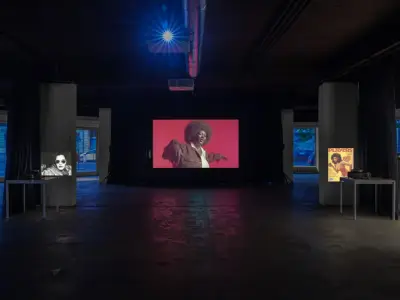Kandis Williams explores topics of race through a multitude of mediums at Walker exhibit

With collage sculptural and video installations Kandis Williams interrogates systems of power in an exhibition now on view at the Walker Art Center the artist s first solo museum show A Surface curated by Walker assistant curator Taylor Jasper with curatorial fellow Laurel Rand-Lewis travels through American filmmaking dance and theater history Greek mythology and racialized violence documenting control in visual forms and exploring pathways toward liberation For her mixed-media collage work Williams works by hand as opposed to digital in meticulous layers In selected works she adds watercolor or ink Others seem to move depending on the viewer s position because they are made with stickers on mirror glass Several of her collages are densely packed while others employ white space to allow her formations to breathe Often she s wrestling with images from pop civilization as well as the more obscure and marginal references that create the work of art I think about the accumulation of images and iconicity and symbolism and how they re never just one image Williams explained me when I met her in the museum I think a lot about what images go into what we consider to be exemplar or ideal how we situate the collected image into one iconographic expression In Atomic Karen Williams juxtaposes images of atomic bombs with different iterations of the goddess Columbia who before she became the poster girl for Columbia pictures was often portrayed as Indigenous in the early engravings from the th century The piece reflects a kind of visual history of the iconography as it layers different historic images that when layered together become recognizable as a symbol that in the modern day we see as a white woman The earlier representations reflected the figure of Columbia as a darker-skinned woman with dress emblematic of a fictional idea of indigeneity Williams takes a deconstructionist approach tracking the history of a particular language vocabulary as a way to reveal both its nuances and its hidden sharp edges The piece grapples with whiteness as a visual language one that s not necessarily static but that has shifted and changed over time and in so doing become codified and internalized In her essay about the piece in the exhibition catalog Jasper writes about the collage s play on the notion of Karen a word that references white female entitlement and Williams fusion of that with images of destruction Through this juxtaposition Williams critiques how systemic structures of whiteness can act as an overwhelming force often unseen but omnipresent with far-reaching consequences Jasper writes Williams also explores the pervasiveness of whiteness in Mothers and Sisters The collage juxtaposes images of anorexia porn with modern-day philanthropists like Bill Gates and Richard Branson as well as American industrials that engaged in the slave commercial sector She also layers in images of the First Bank of Philadelphia an institution that helped expand the institution of slavery as well as white supremacists marching in Charlottesville Va at the bottom of the collage Williams reported me she became horrified when she learned about anorexic porn when she was in college Hailing from Baltimore Williams didn t have thinness so much in her values growing up In the pornographic images she encountered she saw how models would show markers of losing weight by the bulge or their spine or how much space lay between their two fingers as they wrapped around their wrist Kandis Williams Esophagus Pin Up It s about watching them disintegrate she revealed Williams taps into the irony of how the white female ideal when taken to its furthest extreme is like those images of extreme poverty You create the world that creates this challenge and then figure out the language of approach that stabilizes the difficulty Williams declared The true love object of these men is just a kind of unchecked upsurge In the second gallery of the exhibition Williams turns her eye toward movement Williams notified me that while not a dancer herself she s long been interested in the form Growning up in Baltimore which has its own specific cultural and regional dances dance became a way to communicate and move through the world I feel like it s inevitably been a language I think around and in and through she mentioned Williams dance collage works layer in photographs from books and magazines and delve into questions of control appropriation and racism in western dance forms They also contrast different styles as a way to illuminate tactics that white supremacy has lived inside dance traditions for centuries In A Lift and a Kick Conflated Williams creates a kind of diagram with cut-out bodies At the top she places two white balletic figures with the female figure s pelvis perfectly straight her leg kicked up and her arm in a salute Below that are several images of a Black dancer in different poses The Black dancer s hips and core employ a much freer range of motion than the ballet figures Then in the center of the diagram a timid-seeming Mary Wigman the German expressionist dancer who operated her school and company under the Nazi regime stands with her hands clasped together Williams pieces the figures together in such a way that they create a kind of dancing body as a group In creating the motion of dance with her collage she articulates solutions western forms of dance have used a highly regimented form as a way to express a narrative of both class and race Williams also employs faux plants as a point of inquiry Creating sculptural plants with images of Black laborers chain gangs vintage porn and Uruguayan tango the work looks to the history of exploitation of Black bodies as well as the means humans have manipulated and even personified plants Central to this section is a video called Annexation Tango where a Black dancer performs a movement mixing tango voguing and other contemporary forms of dance that have often been appropriated and then erased their African roots Juxtaposed with the dancer are historical images of slavery and footage of prison farms linking appropriation to America s bulk violent past In the last section of the exhibition Williams takes a kind of collage approach to her video installation For The Death of A she draws on Arthur Miller s play Death of a Salesman Death of A re-centers the play around a Black man portrayed by actor Jerod Haynes Haynes performs a soliloquy in the piece which is layered with text and archival footage that situates the story within American hegemony Kandis Williams A Surface runs through Aug at the Walker Art Center More information here The post Kandis Williams explores topics of race through a multitude of mediums at Walker exhibit appeared first on MinnPost


